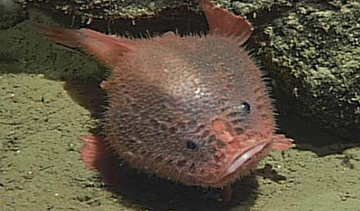291113-frog fish.jpg

A frogfish at Davidson Seamount, southwest of Monterey, California. Credit: National Oceanic and Atmospheric Administration
The frogfish is a master of deception. It can disguise itself as a rock, a bit of coral, or even a sea urchin as it lies in wait for unsuspecting prey. When a potential meal gets close, it dangles a lure that looks like a wiggling worm or a small shrimp. And at just the right instant, it sucks in the prey faster than the blink of an eye.
Frogfish are found in tropical waters across much of the world. Their stubby bodies can grow to more than a foot in length. And they use the fins on the underside of the body to hop like a frog or even trot across short distances.
When it’s not in disguise, a frogfish looks a bit lumpy, like a mound of bread dough waiting to be made into a loaf. As it settles in to wait for prey, though, it transforms itself. Not only does it change color, it also can change its shape. A combination of skin flaps, stringy filaments, and other appendages allow it to disguise itself as rocks or other objects on the sea floor. One species has been seen masquerading as a sea urchin.
Frogfish are members of the larger group known as anglerfish, so they have built-in fishing lures that dangle above their mouths to attract prey.
And when the shrimp, fish, or other prey gets close enough, the frogfish opens its jaws wide and vacuums up the prey in a flash – less than a hundredth of a second. The wide jaw and an expanding stomach allow it to eat prey that’s larger than itself. After that, it’s back to the disguise – waiting for the next meal to fall for the deception of the frogfish.

